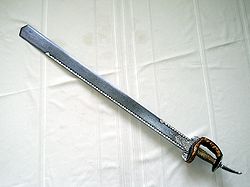- Khanda (sword)
-
Khanda 
A Rajput khandaType Sword Place of origin India Service history Used by Marathas, Rajputs and Sikhs Production history Produced Similar weapons used from at least the Gupta period (320-550 AD) to present Specifications Blade type Double-edged, straight bladed, blunt tipped - For the Sikh symbol, see Khanda (religious symbol)
- For the sword described in Indian legend, see Asi (Mahabharata)
The khanda (from Sanskrit खड्ग khaḍga) is an Indian double-edge straight sword. Created by the Rajputs, it was also used by the Sikhs, Marathas and Jats.
The blade is usually broad and quite heavy and broadens from the hilt to the tip. The blade transforms into tip rather abruptly. The hilt has a small metal spike coming out in the opposite direction typical of the khanda. Many other straight swords around the world were primarily used for thrusting and stabbing with the tip, whereas the khanda was mainly used to hack or cleave with the edge of the blade.
The khanda and related straight swords are generally used in Indian theatre and art to represent the weapons of the ancient period of Indian history. Some religious iconography, such as statues of Kali, feature it. Rajputs venerate the weapon as a symbol of Shiva. Straight swords are used in the classical kathakali dance form, and the related martial art kalaripayat.
Contents
History
The modern Indian word khanda has its origins in the Sanskrit word khaḍga or khaṅga, from a root khaṇḍ meaning "to break, divide, cut, destroy". The older word for a bladed weapon, asi, is used in the Rigveda in reference to either an early form of the sword or to a sacrificial knife or dagger. Such early swords appear in the archaeological record of Northern India with the Ochre Coloured Pottery culture, from about 1500 BC, although the Puranas and Vedas give an even older date to the knife. The Khadga is believed to be one of the many weapons of the Hindu God Vishnu.
Straight swords, (as well as other swords curved both inward and outward), have been used in Indian history since the Iron Age Mahajanapadas (roughly 600 to 300 BC), being mentioned in the Sanskrit epics, and used in soldiers in armies such as those of the Mauryan Empire (320-185 BC). Several sculptures from the Gupta era (AD 280-550) portray soldiers holding khanda-like broadswords. These are again flared out at the tip. They continued to be used in art such as Chola era murtis.
Middle Ages
There is whole host of paintings depicting the khanda being worn by Rajput kings throughout the medieval era. In Rajput traditions, the khanda was plied with both hands and was double-edged. It was used usually by foot-soldiers and by nobles who were unhorsed in battle. The Rajput warrior clans venerated the khanda as a weapon of great prestige.
According to some, the design was improved by Prithviraj Chauhan.[citation needed] He added a back spine on the blade to add more strength. He also made the blade wider and flatter, making it a formidable cutting weapon. The new design proved very effective against the leather inlaid chain mail armour of Muslim invaders. It also gave a good advantage to infantry over light cavalry enemy armies.
Rajput warriors in battle wielded the khanda with both hands and swung it over their head when surrounded and outnumbered by the enemy. It was in this manner that they traditionally committed an honourable last stand rather than be captured. Even today they venerate the khanda on the occasion of Dasara.
Maharana Pratap is known to have wielded a khanda.
See also
References
- The History and Culture of the Indian People - Bharatiya Vidya Bhawan
- Hindu Arms and Ritual - Robert Elgood
- Annals and Antiquities of Rajasthan - Colonel James Tod
- When the Body Becomes All Eyes: Paradigms, Discourses and Practices of Power in Kalarippayattu, a South Indian Martial Art - Phillip B. Zarrilli
- The Art of War in Ancient India - P.C. Chakravarti
External links
Categories:- Blade weapons
- Indian swords
- South Asian swords
- Weapons of India
- Medieval weapons
Wikimedia Foundation. 2010.
